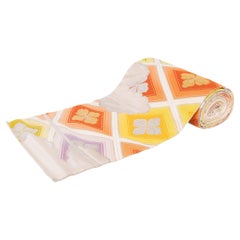Fabric Asian Art and Furniture
Late 20th Century Uzbek Suzani Fabric Asian Art and Furniture
Cotton, Silk
Late 20th Century Uzbek Suzani Fabric Asian Art and Furniture
Cotton, Silk
20th Century Japanese Fabric Asian Art and Furniture
Silk
Late 20th Century Uzbek Suzani Fabric Asian Art and Furniture
Cotton, Silk
Early 20th Century Japanese Taisho Fabric Asian Art and Furniture
Gold
Late 20th Century Uzbek Suzani Fabric Asian Art and Furniture
Cotton, Silk
20th Century Japanese Fabric Asian Art and Furniture
Hemp
18th Century Japanese Antique Fabric Asian Art and Furniture
Gold Leaf, Iron, Metal
21st Century and Contemporary Uzbek Suzani Fabric Asian Art and Furniture
Cotton, Silk
1880s Chinese Qing Antique Fabric Asian Art and Furniture
Canvas
1980s Balinese Folk Art Vintage Fabric Asian Art and Furniture
Canvas
1980s Japanese Showa Vintage Fabric Asian Art and Furniture
Metallic Thread
Mid-20th Century Japanese Japonisme Fabric Asian Art and Furniture
Silk
Early 20th Century Japanese Taisho Fabric Asian Art and Furniture
Silk
Late 20th Century Uzbek Suzani Fabric Asian Art and Furniture
Cotton, Silk
21st Century and Contemporary Japanese Fabric Asian Art and Furniture
Silk, Acrylic
Early 19th Century Japanese Antique Fabric Asian Art and Furniture
Silk, Wood, Lacquer, Paint, Paper
Late 20th Century Uzbek Suzani Fabric Asian Art and Furniture
Cotton, Silk
21st Century and Contemporary Japanese Fabric Asian Art and Furniture
Silk, Thread
17th Century Spanish Baroque Antique Fabric Asian Art and Furniture
Fabric
2010s Indian Fabric Asian Art and Furniture
Cotton
20th Century Tibetan Fabric Asian Art and Furniture
Metal
20th Century Tibetan Tang Fabric Asian Art and Furniture
Wool
Early 19th Century Uzbek Suzani Antique Fabric Asian Art and Furniture
Cotton, Linen, Silk
Early 20th Century Japanese Fabric Asian Art and Furniture
Bronze
19th Century Tibetan Antique Fabric Asian Art and Furniture
Canvas, Glass, Wood
19th Century Japanese Antique Fabric Asian Art and Furniture
Silk
19th Century Japanese Antique Fabric Asian Art and Furniture
Cotton
Mid-20th Century Taisho Fabric Asian Art and Furniture
Wood, Fabric
Early 19th Century Chinese Antique Fabric Asian Art and Furniture
Silk, Paper
1990s Turkmen Other Fabric Asian Art and Furniture
Cotton, Silk
2010s Argentine Other Fabric Asian Art and Furniture
Cotton
1920s Showa Vintage Fabric Asian Art and Furniture
Fabric, Wood
21st Century and Contemporary Japanese Fabric Asian Art and Furniture
Silk, Thread
21st Century and Contemporary Japanese Fabric Asian Art and Furniture
Silk, Thread
Early 20th Century Japanese Fabric Asian Art and Furniture
Silk
19th Century Japanese Antique Fabric Asian Art and Furniture
Cotton
1960s French Vintage Fabric Asian Art and Furniture
Canvas, Wood
21st Century and Contemporary Japanese Fabric Asian Art and Furniture
Gold Leaf
Late 19th Century Chinese Antique Fabric Asian Art and Furniture
Silk
Late 19th Century Japanese Meiji Antique Fabric Asian Art and Furniture
Silk, Wood
Early 1900s Japanese Meiji Antique Fabric Asian Art and Furniture
Ceramic, Earthenware, Pottery, Faux Leather
Mid-20th Century Japanese Anglo-Japanese Fabric Asian Art and Furniture
Silk
18th Century Chinese Other Antique Fabric Asian Art and Furniture
Silk
1970s French Art Deco Vintage Fabric Asian Art and Furniture
Wool
Mid-20th Century Chinese Chinese Export Fabric Asian Art and Furniture
Silk, Wood
2010s Chinese Fabric Asian Art and Furniture
Silk
Late 19th Century Japanese Meiji Antique Fabric Asian Art and Furniture
Silk, Wood
Late 20th Century Uzbek Suzani Fabric Asian Art and Furniture
Cotton, Silk
Late 19th Century Japanese Meiji Antique Fabric Asian Art and Furniture
Silk, Wood
19th Century Japanese Edo Antique Fabric Asian Art and Furniture
Brass, Gold Leaf
21st Century and Contemporary Uzbek Suzani Fabric Asian Art and Furniture
Cotton, Linen, Silk
Mid-20th Century Chinese Fabric Asian Art and Furniture
Silk, Upholstery, Hardwood
Late 20th Century Chinoiserie Fabric Asian Art and Furniture
Silk
Early 19th Century Korean Antique Fabric Asian Art and Furniture
Cotton, Paint
20th Century Japanese Anglo-Japanese Fabric Asian Art and Furniture
Metal
Late 19th Century Antique Fabric Asian Art and Furniture
Silk, Paper
Early 20th Century Indian Folk Art Fabric Asian Art and Furniture
Cotton
Read More
Chicago’s Pagoda Red Has a Spirited Mix of Asian Antiques and Bold New Art
For 25 years, gallerist Betsy Nathan has leveraged her keen eye and key connections to bring a unique selection of rare finds to the market.
In L.A., Gallerist JF Chen Has Long Championed Eclectic Blue-Chip Design
Now working alongside his daughter Bianca, dealer Joel Chen has presented a most covetable array of antiques, art and contemporary creations for more than 40 years.
12 Calming Spaces Inspired by Japanese Design
From cherry-blossom-adorned walls paired with glamorous lighting to wood-paneled ceilings above checkerboard-patterned chairs, these 12 spaces seamlessly blend Eastern and Western aesthetics.
Rodrigo Rivero Lake’s Mexico City Showroom Is a Museum-Worthy Trove of Spanish Colonial and Asian Antiques
The dealer and curator has spent the past 50 years amassing a collection of exceptional art, furniture and architectural elements that trace the cultural influence of the Spanish empire from Europe to the Americas and beyond.
16 Refined Asian-Inspired Interiors
These spaces exemplify how Eastern elements elevate a home's decor.

